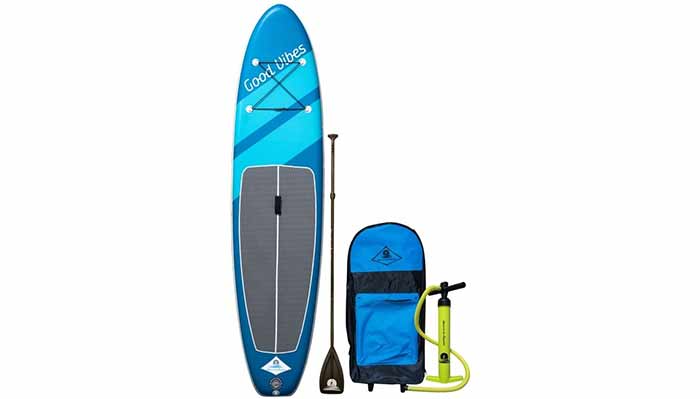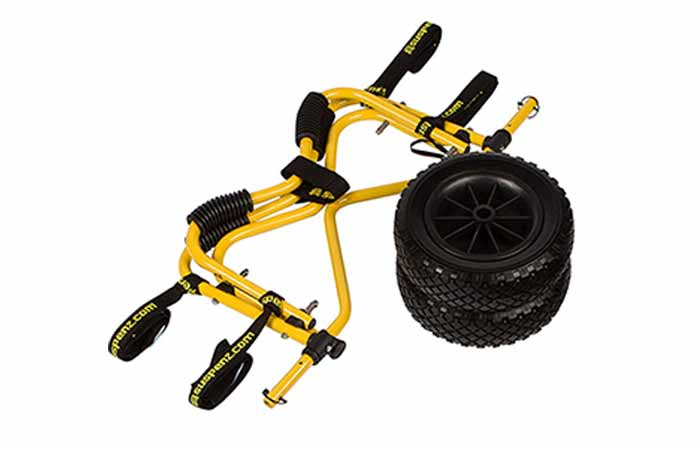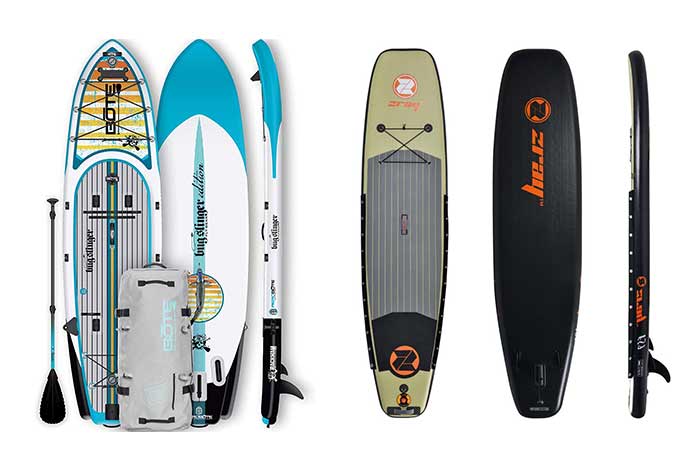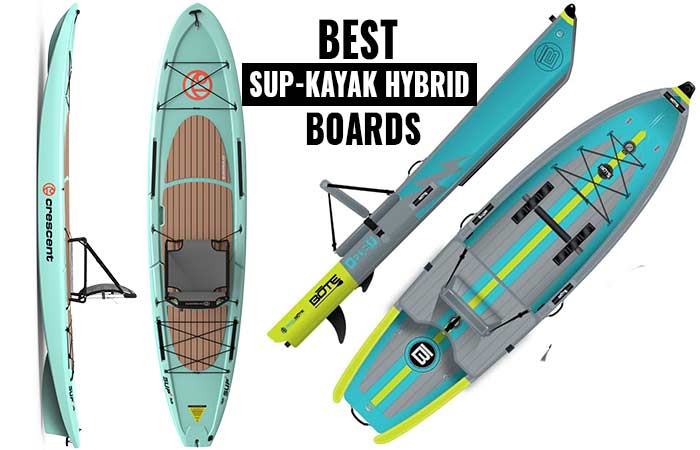How Long Do Inflatable Paddle Boards Last?
Inflatable boards are known for their multiple advantages compared to solid paddleboards; most notably their durability. Inasmuch as ISUPs can stay for some time, it is still important to have a rough idea of exactly when you should expect tears, punctures, scratching or dropping that will make them unusable.
Inflatable paddle boards can last for quite a number of years; an average of 2-3 or more years, basing on a substantial number of seasoned paddlers. However, this depends on a couple of factors like, the quality of the board, how often you use it and how well your board is handled.
Read on for details plus ideas to increase longevity and usability.
Inflatable Paddleboard Durability
There’s no straight forward or fixed answer when it comes to how durable this water sport equipment is. Durability varies depending on a number of factors. However, if well handled, you can expect Inflatable Stand Paddleboards to last between two to three or more years before you go searching for a replacement.

Factors that Determine how long ISUPs last
How long your paddleboard will last primarily depends on three major factors. These are;
- Care of the board
- Construction
- Brand/ cost
- Condition of the board (second-hand product or brand new)
1. Care of the Board
Your board has a higher chance of lasting longer if you took the time to actually take care of the board. For example, what do you do after a session of paddleboarding?
Your board has been exposed to the sun for about two hours; the time you spent partaking in the recreational activity. Hence, you ought to store it properly in a protective bag until your next session. The sun has UV rays with radiation vectors that are potentially harmful to your board; especially its rigidity. Which is why you need to store it away from the direct sunlight until your next escapade.
Before folding up your board into a storage unit or bag, you should ensure its dry. More often than not, you carry around water from the lake, or wherever else you were paddleboarding. The residual water left floating around your board can create a conducive environment for the growth of mildew. You all know how disgusting and unsightly the look of mildew is.
Cleaning your board also entails removing the dirt and sand from the board before you fold it up. This is because as you’re transporting it, the board material and the sand will rub against each other causing scratch marks and even wear and tears. Hence, hose down your boards with plenty of water before storage.
2. Construction
Certain elements about a board’s construction can affect its longevity. Let’s take a look at some of the features.
Multiple layers vs. Single layer
Inflatable paddleboards are made from PVC, but you will more than more durable products will be made from multiple layers of mil-spec PVC. This means that they have been constructed with the more tensile strength to resist extreme pressure like from a deep dive.
With either two to four layers, the board is protected from constant tearing, punctures, and deep cuts. They’re no match for a single-layered board that can easily default in the middle of your session.
Seaming Design
Layering is not the only factor you should look at; how the seams are joint together can also significantly affect its longevity. Unpopular brands or inexpensive board companies will manufacture these products using seam glue. That’s not a bad choice, but it’s not excellent either.
Because of exposure to extreme water pressure, the UV radiation, and air, the seam will eventually give in by degrading the glue and causing the seam to burst right open. This is rather discouraging because you will have to cover a greater amount of expense to repair than it was worth originally.
Look for a paddleboard with a mechanically welded seam. These have been passed through extreme heat and ultrasonic radiation creating a mechanical seal, which is not only excellent at resisting pressure but adds to its durability. The seam will last even longer than the PVC material used to make the board.
Protective Layering
It’s not enough to have a glossy board that glides easily on the water, you also need a UV coat. These will repel the UV radiation that can potentially degrade your board. The added sunblock will protect the layering of the board for as long as the coat is viable. This, however, doesn’t warrant you to store the board under direct sunlight
3. Brand & Quality
You all know that there’s always that one company or various brands that produce top-notch paddleboards. From the construction finesse to added accessories and other great features; but their cost is over the roof.
But that’s a non-issue when you consider how long the board will last you once you decided to make that one-off investment. More so, known brands will offer you linger warranty because they believe in their products. You will see a 5-year guarantee on a paddleboard meaning the company is confident in their products and are willing to offer any replacements or repairs within that period.
4. Condition of the Board
This is pretty self-explanatory. If the board is brand new and of good quality, it will last but if it a second hand it will in most cases won’t last.
Tips to Lengthen your Board’s lifespan
You’ve read about how long a typical paddleboard can last you, and you’ve also seen the factors that can affect its durability, let’s now wind up with some tips on how you can make your paddle board stay longer.
Keep It Clean
It’s that simple, always ensure you rinse off your board once you’re done using it. You’re not only removing the dirt, sand, grime, and muck, but also other debris. You’ll also be rinsing off the saltwater that can damage the coating of the board. This also goes even if you were boarding in freshwater waters.
Keep It Dry
Whether you sundry or wipe with a towel, always keep the board dry before you store it. This way, you will avoid any growth of mildew. More so, the water can put pressure on the seaming of the board, causing it to degrade faster than it originally would.
Storage
This is the most critical factor you should pay keen attention to. You want to store the board well, so you can be able to transport it well, among other receeding things. Because it’s inflatable, you simple deflate, fold, and store in a protective case. However, you have to do it right.
Once the board is dry, deflate it gently, then check for any tears, scratches, puncture wounds or damages. Check the air valve for any remaining water or dirt/ debris. If any, hose down your board till it’s clean. Then finally, lock and close the air valves so nothing gets in there as you’re transporting it.
If your paddleboard has attached fins, always detach it before you store. Carry them in a separate bag and always keep them in a cool and dry environment.
Occasional Scrubbing
After using the paddleboard for quite some time, you may need to scrub it some more to remove the not so friendly marks on your board. The stubborn stains and grime can be removed using a detergent and soft cloth and water to rinse off. You can do this semi-annually so you’re not scrubbing it too much.
If you don’t trust tour local detergent, get a specified paddleboard wash soap from the store with mild chemicals to clean off the dirt. After your cleaning, ensure you apply a UV concealment. You already know how harmful the UV rays can be to your board. So add some bit of sunblock and buff it with a soft cloth.
Repair Damage Immediately
The reason why you need a maintenance routine is so that you are always aware of damages or any necessary repairs if any. You can avoid accidents or incidents the earlier you spot a problem and repair it immediately. Especially for minor damages like a nick or a simple scrape, it’s very fast to repair/ service.
Remember small punctures can cause bigger problems like the board deflating as your boarding which can be a very dangerous situation. You could also carry along with you an epoxy sealant. This will be used to fix any cuts. If unsure, you can also seek professional assistance.
Proper Handling
Last but not least is how you handle the board. It may be made with durable materials, multilayer military-grade PVC, but it can rip, tear, or simply spoil if you don’t handle with care. This includes;
- Don’t drag it along the ground
- Store the board while deflated, if inflated, ensure space is enough to fit it completely.
- Valves are locked and closed securely in its place.
- Don’t place or store anything on top of the board.
These are only but a few things you can consider when it comes to playing keen attention to how you handle your board.
Further SUP Ideas & How-tos
The following is a collection of more Stand up paddleboarding ideas and board guides
SUP Equipment & Accessories
- Best Large SUPs for Bigs Guys & Multi-person(2-6)
- Best Bamboo Paddle Boards
- Best SUP-Kayak Hybrid Boards
- Best Fishing SUPs
- Best Pumps for Inflatable Stand Up Paddleboards(ISUPS)
- What Size Paddle Board Do I Need?
- Types of Stand Up Paddleboards
- Inflatable vs Solid/Rigid Paddleboards
- How to Store SUPs-Storage Ideas & DIY Option
- Best Paddle Board Roof Racks for Cars, SUVs & Trucks
Paddleboarding
- What to Wear for Stand Up Paddleboarding?
- How to Paddle Board-Is it Hard? SUP Beginner Techniques & Tricks
- SUP Paddleboarding Tips & Tricks Every Paddleboarder should know
- How to Get on a Paddle Board, After Falling & from a Dock
- How many Calories does Paddleboarding Burn?
- Best Paddle Board Workouts/Exercises to Improve Your Fitness
- Benefits of Paddleboarding(SUP)







